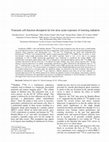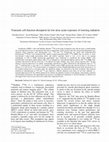Papers by priyanka saxena

Indian Journal of Experimental Biology, Dec 1, 2011
Incubation of BMG-1 cells with thallium chloride ( 201 Tl) in the range of diagnostic dose did no... more Incubation of BMG-1 cells with thallium chloride ( 201 Tl) in the range of diagnostic dose did not show a smooth uptake curve and appeared to have an unsuspected deviation in initial phase. In the present study this unexpected phenomenon was explored, using commonly used radionuclides (viz., 201 Tl and 131 I). Comparison was made with technetium-99m pertechnetate ( 99m TcO 4 -) and technetium-99m labeled methoxyisobutylisonitrile ( 99m Tc-MIBI) that are known to show conventional 2 phase graph representing inflow and outflow segments. Serial in vitro, ex-vivo and in vivo gamma scintigraphy as well as NMR spectroscopy experiments were conducted to corroborate the results. BMG-1 cells demonstrated a four-phase uptake pattern with 201 Tl as compared to a conventional biphasic pattern with 99m Tc-MIBI. Flow cytometry data however did not reveal any 201 Tl induced cell injury. Further, mice tissue extracts injected with 201 Tl also showed a transient depression in its uptake. Scintigraphy experiments in rabbits administered with diagnostic dose of 201 Tl and 131 I confirmed the in vitro and ex vivo findings. Further, proton NMR spectroscopy showed decrease in the level of choline at 3 h and 24 h in 201 Tl treated animals as compared to control. Phosphoethanolamine peak firstly decreased at 3 h but reached normal level at 24 h time point. No significant change was observed in the level of betaine. This transient reduction in internalization of 201 Tl and 131 I may represent a hitherto unknown acute effect of low dose radiation, i.e., transient depression in Na + -K + ATPase pump activity without any apparent evidence of cell damage, representing a transient cell membrane dysfunction. The phenomenon may present a mechanistical explanation of 'thyroid stunning' at cellular level and suggest that it may be more universal in nature than suspected till now.

Indian journal of experimental biology, 2011
Incubation of BMG-1 cells with thallium chloride (201Tl) in the range of diagnostic dose did not ... more Incubation of BMG-1 cells with thallium chloride (201Tl) in the range of diagnostic dose did not show a smooth uptake curve and appeared to have an unsuspected deviation in initial phase. In the present study this unexpected phenomenon was explored, using commonly used radionuclides (viz., 201Tl and 131I). Comparison was made with technetium-99m pertechnetate (99mTcO4(-)) and technetium-99m labeled methoxyisobutylisonitrile (99mTc-MIBI) that are known to show conventional 2 phase graph representing inflow and outflow segments. Serial in vitro, ex-vivo and in vivo gamma scintigraphy as well as NMR spectroscopy experiments were conducted to corroborate the results. BMG-1 cells demonstrated a four-phase uptake pattern with 201Tl as compared to a conventional biphasic pattern with 99mTc-MIBI. Flow cytometry data however did not reveal any 201Tl induced cell injury. Further, mice tissue extracts injected with 201Tl also showed a transient depression in its uptake. Scintigraphy experiment...

Indian journal of experimental biology, 2014
With an aim to devise a prophylactic and/or therapeutic approach for preventing internalization o... more With an aim to devise a prophylactic and/or therapeutic approach for preventing internalization of radiothallium (201Tl), and more importantly by implication, its chemical analogue radiocesium (137Cs) during any nuclear emergency, different ex vivo and in vivo animal models were created to determine the role ofpH in absorption of 201Tl across jejunum/muscle tissue and whole body retention of 201Tl respectively. Movement of Tl+ under simulated pH conditions proved that pH had direct influence on its absorption. Oral intake of acidified water or parenteral administration of lactic acid was able to reduce the body burden of 201Tl by up to 12 and 50% respectively. The results indicate that acidification of gut, within physiological range may be used as an option for decorporation/inhibition of incorporation of radiothallium and radiocesium, particularly in cases of mass casualty.
Algal Biorefineries, 2013

Journal of Chemical Technology & Biotechnology, 2013
ABSTRACT BACKGROUND: Hydroponic greenhouse effluent has high concentrations of total phosphorus (... more ABSTRACT BACKGROUND: Hydroponic greenhouse effluent has high concentrations of total phosphorus (30–100 mg PO4-P L−1) and nitrates (200–300 mg NO3-N L−1). Current technologies for effluent treatment have limitations of performance and high maintenance costs. The goals of this study were to investigate strategies which combine alkali treatment and microalgae cultivation for removal of nutrients from hydroponic greenhouse effluent. RESULTS: Treatment with strong alkali was found to effectively remove 97% of total phophorous especially in the form of phosphate, without affecting the nitrate ion concentration in the greenhouse effluent. After alkali treatment, marine algae Dunaliella salina (UTEX 1644) cultivation on treated hydroponic effluent (pH 7.5) showed > 80% decrease in nitrate content in the effluent within 4 days of cultivation. In the same period, the carotene content of the micro-algal system was in the range 0.5 ± 0.02 µg mg−1 (dry cell weight) which was 1.5 times higher than in the control. CONCLUSION: This study demonstrated that combination of a conventional alkali precipitation method with a microalgae treatment system is a highly efficient approach for the removal of excess nutrients from hydroponic greenhouse effluent in a short treatment time. The microalgae can provide a source of value in the form of carotene. © 2012 Society of Chemical Industry

Critical Reviews in Biotechnology, 2013
In recent years, the not too distant exhaustion of fossil fuels is becoming apparent. Apart from ... more In recent years, the not too distant exhaustion of fossil fuels is becoming apparent. Apart from this, the combustion of fossil fuels leads to environmental concerns, the emission of greenhouse gases and issues with global warming and health problems. Production of biodiesel from microalgae may represent an attractive solution to the above mentioned problems, and can offer a renewable source of fuel with fewer pollutants. This review presents a compilation of engineering challenges related to microalgae as a source of biodiesel. Advantages and current limitations for biodiesel production are discussed; some aspects of algae cells biology, with emphasis on cell wall composition, as it represents a barrier for fatty acid extraction and lipid droplets are also presented. In addition, recent advances in the different stages of the manufacturing process are included, starting from the strain selection and finishing in the processing of fatty acids into biodiesel.

Uploads
Papers by priyanka saxena